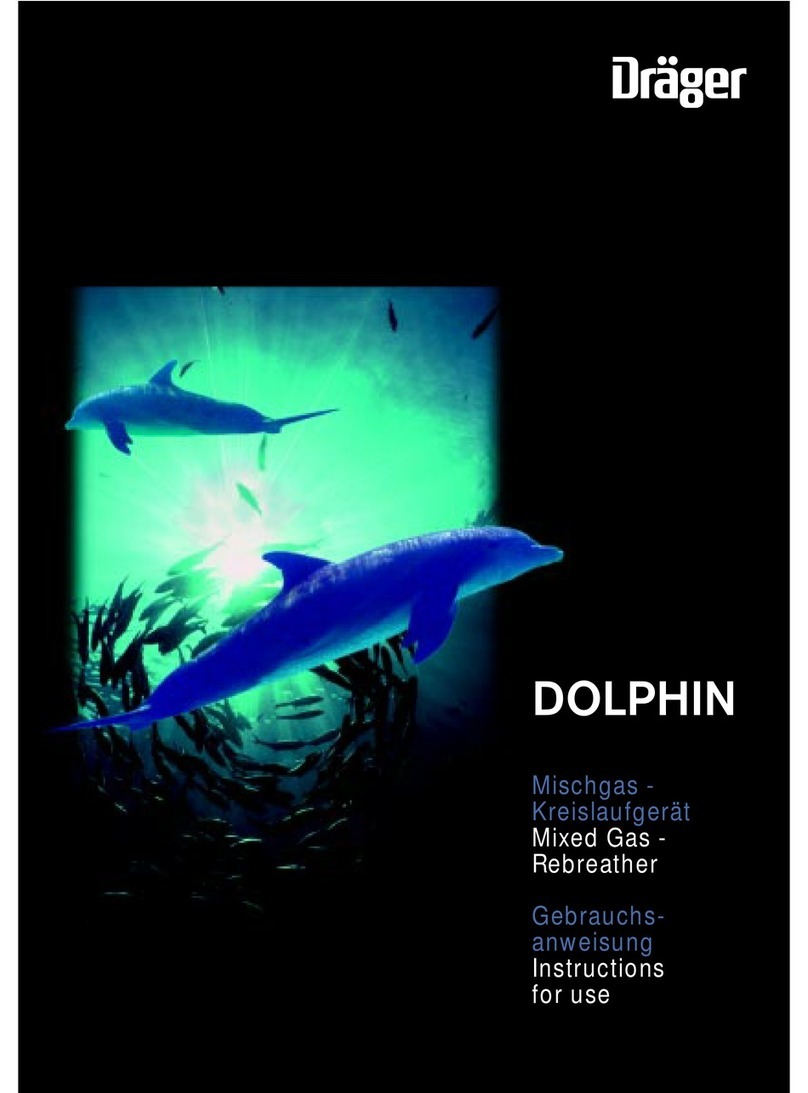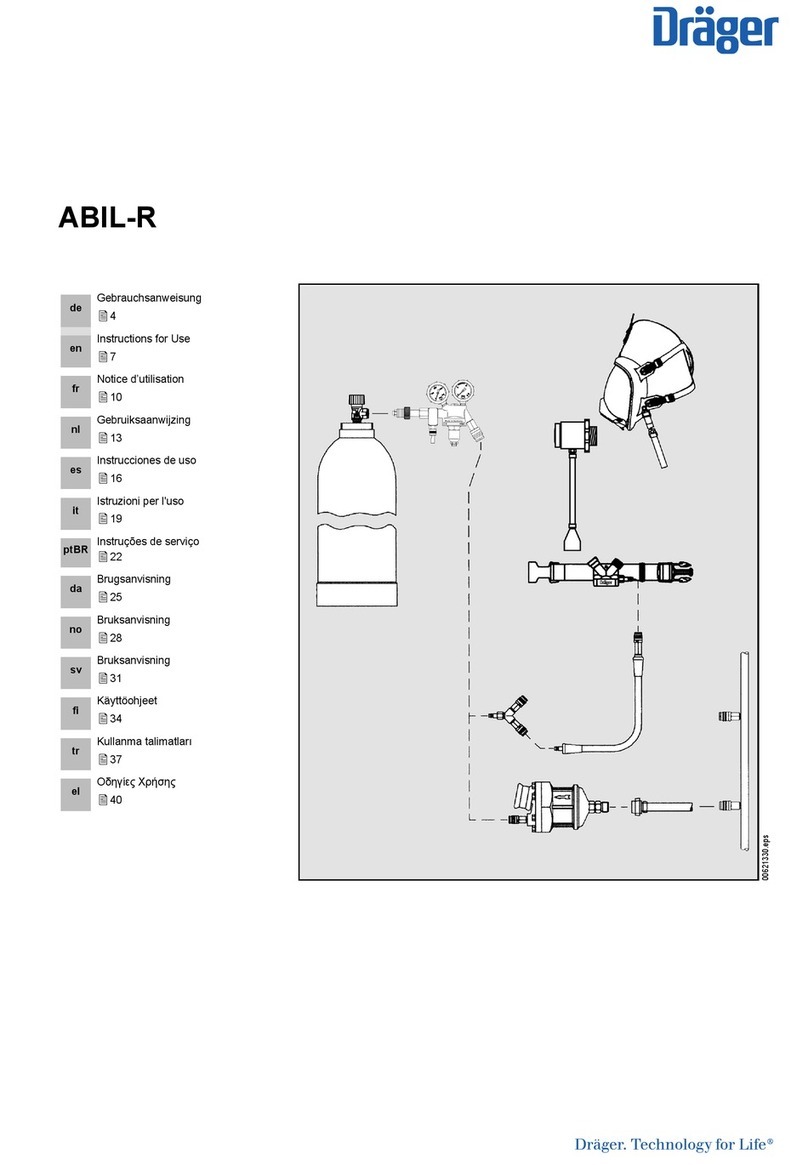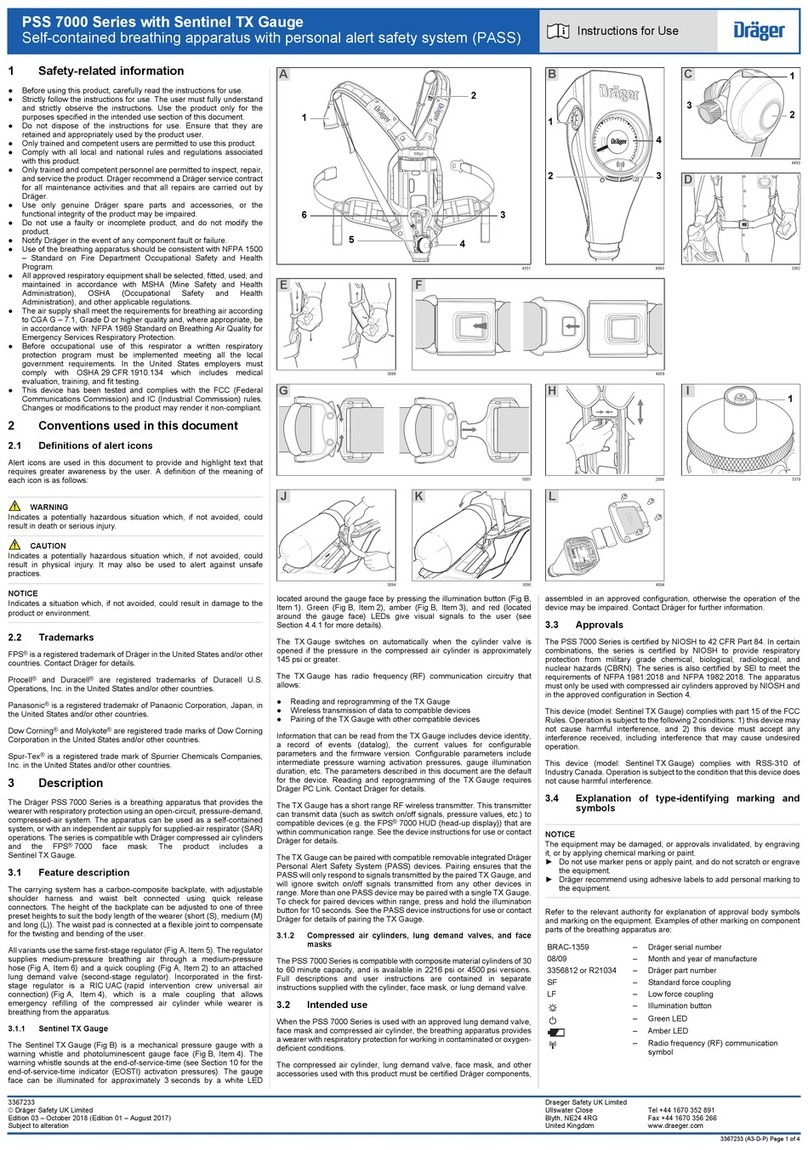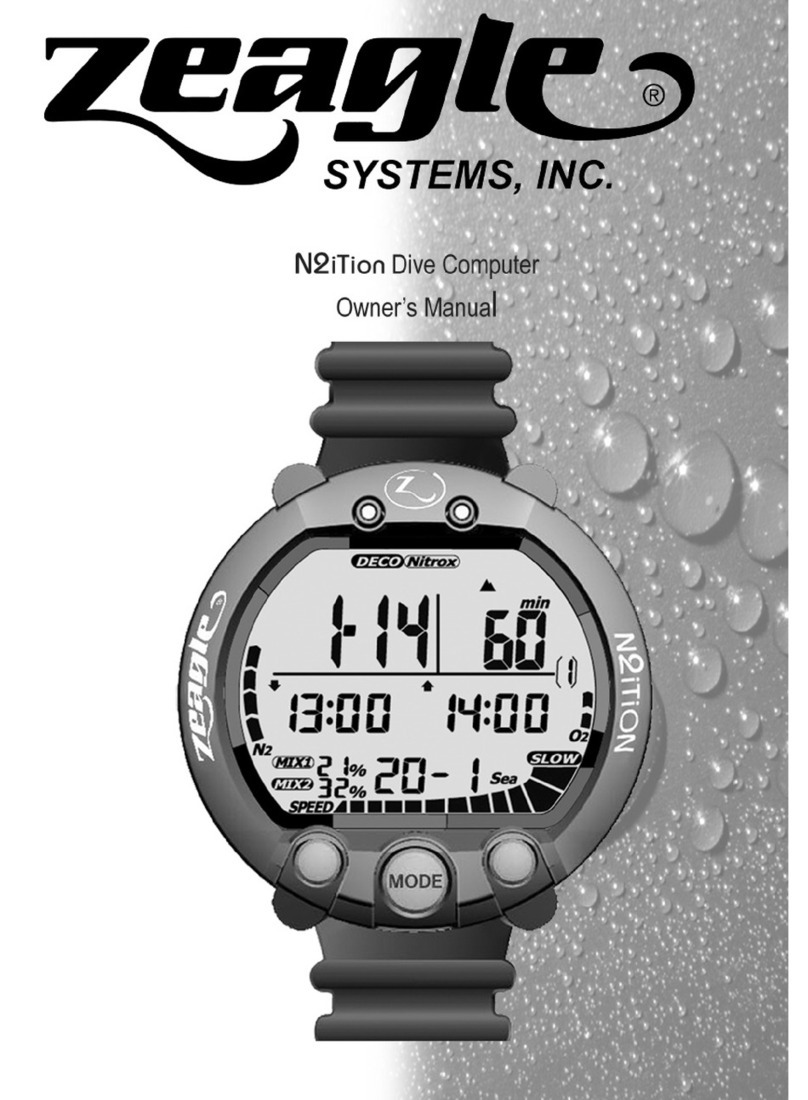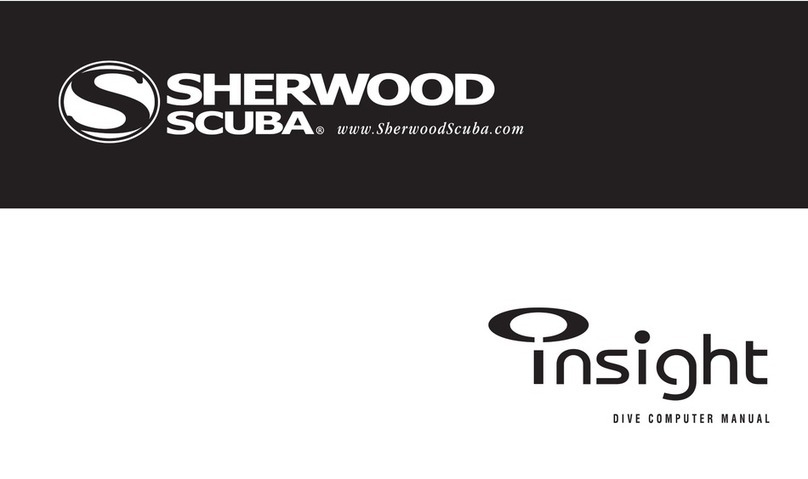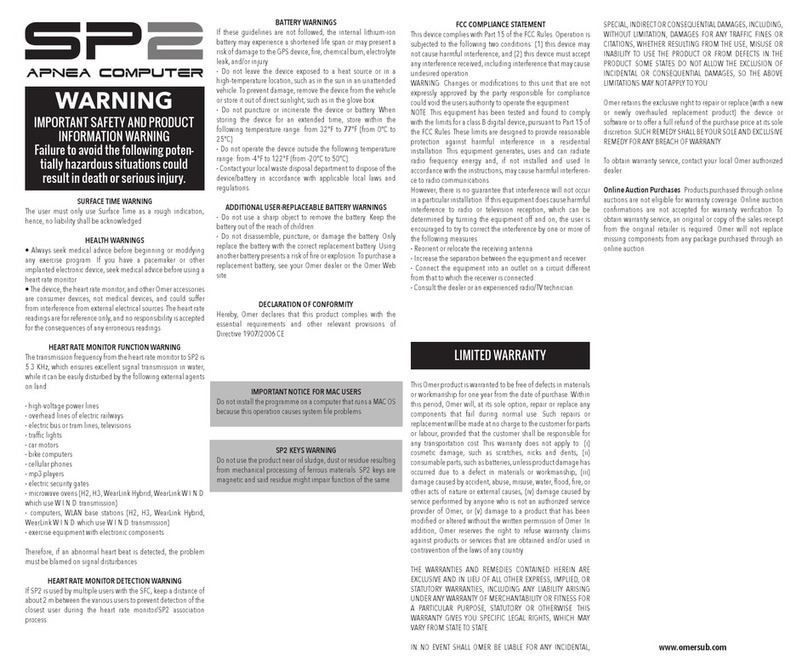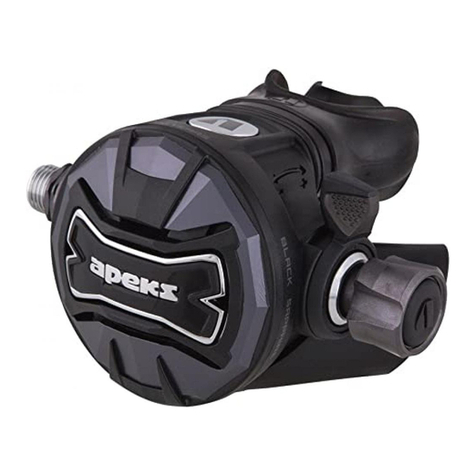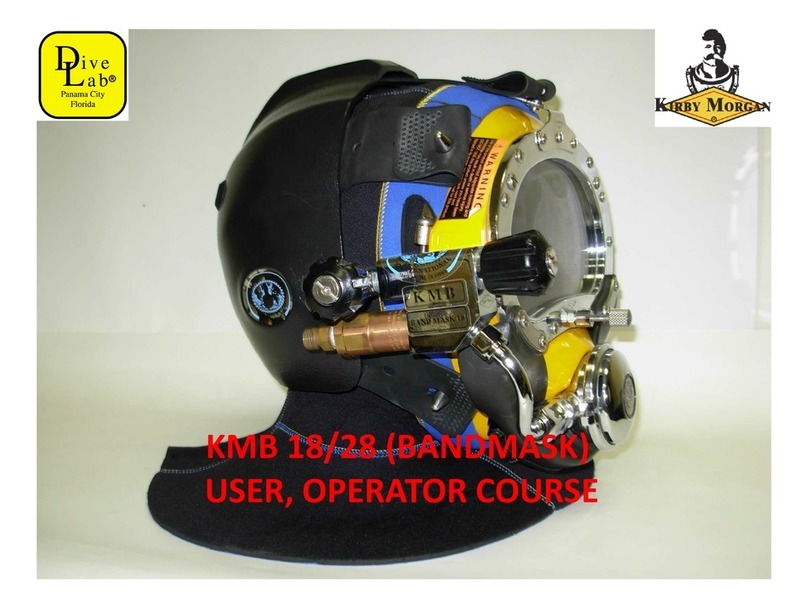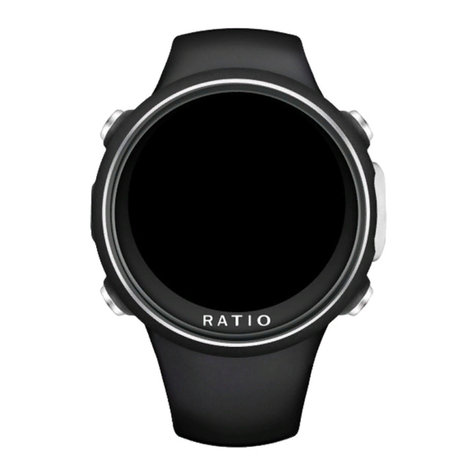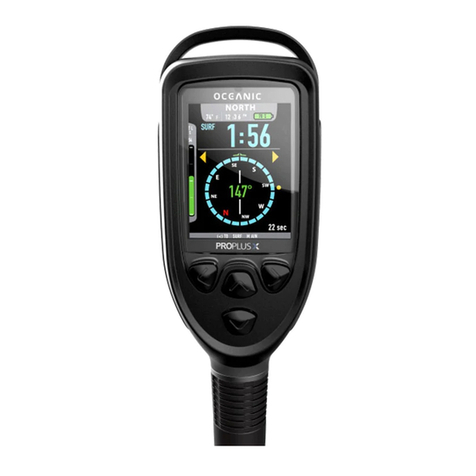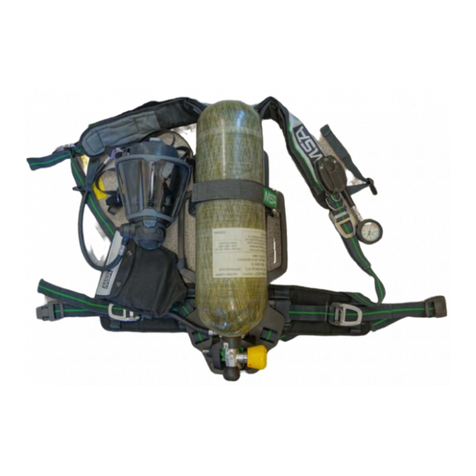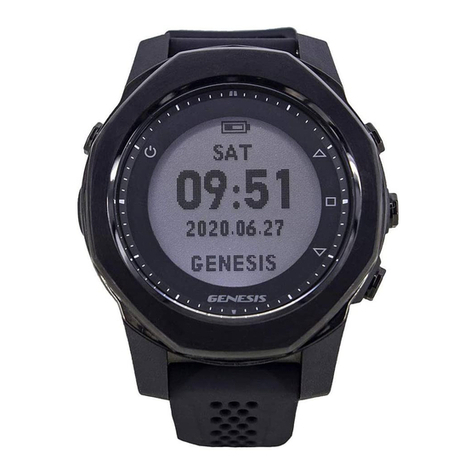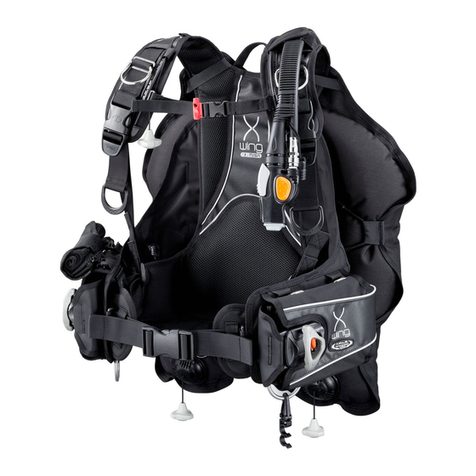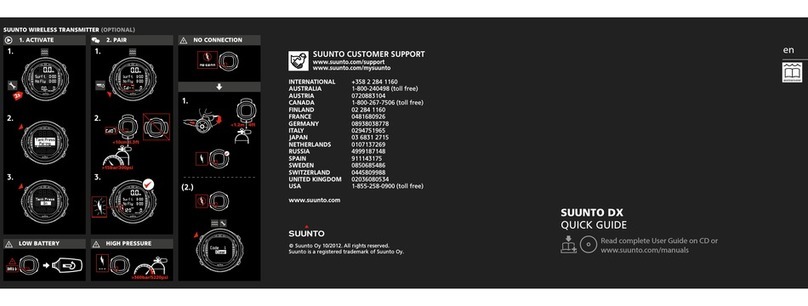
Dräger PAS AirPack 1 Trolley Module
Airline Compressed Breathing Air Supply System Instructions for Use
3352691 : 'D' Edition : October 2003 : Subject to Modification
1
1642
Approvals
The Drä er PAS AirPack 1 Trolley Module conforms to the requirements of EN139 and meets the
requirements of EC Council Directive PPE (89/686/EEC) and PED (97/23/EC).
PPE EC Type examiner; SGS United Kin dom Limited, Unit 202b, Worle Parkway, Weston-super-
Mare, BS22 0WA, UK. Notified Body No. 0120. CE Mark approved and issued with EC Type Examination
Certificate.
PED EC Type examiner; Lloyds Re ister, Hiramford, Middlemarch, Office Villa e, Siskin Drive, Coventry,
CV3 4FJ, En land. Notified Body No. 0038. The equipment is manufactured in accordance with the
requirements of Conformity Assessment Trolley Modules B + D of the Pressure Equipment Re ulations.
A copy of the Declaration of Conformity is available from Drä er on request.
For Your Safety
The Drä er PAS AirPack 1 Trolley Module incorporates a hi h performance pressure reducer. The reducer
is factory set and must not be tampered with, or removed from the manifold, as this invalidates the
conditions of the Drä er warranty. Correct operational condition is valid only if Drä er service and re-
seals the pressure reducer.
uUse of this equipment requires wearer trainin and observance of these Instructions for Use and the
Instructions for Use supplied with the selected associated breathin equipment.
uUse the equipment for the purpose specified in this instruction, or as confirmed in writin by Drä er.
uUse and maintenance of this equipment requires knowled e and compliance with National Re ulations,
Laws and Standards overnin the use of respiratory equipment in the country of use.
uOnly trained competent personnel should inspect and service the equipment at re ular intervals and
a record kept of such inspections and service.
uOnly trained and competent personnel should carry out the char in of the compressed air cylinders.
uDrä er recommends that a Service Contract be obtained from your Drä er Branch or A ent.
uContact Drä er for details of Service Contracts and Service Trainin Courses.
uUse only ori inal Drä er Spare Parts for service and maintenance.
uUse only ori inal Drä er Test Equipment for service and maintenance.
uNotify Drä er if there is a component fault or failure.
Liability Statement
Terms and Conditions of warranty for the Drä er PAS AirPack 1 Trolley Module can be obtained from Drä er
on request. Responsibility for reliable function of the equipment transfers to the owner or operator when
serviced or repaired by untrained personnel, (not employed or authorised by Drä er), or when used in a manner
not conformin to its intended use.
Description and Intended Use
The Drä er PAS AirPack 1 Trolley Module is a
compact mobile two-wheel trolley unit with
flexible rubber airline hose and hose windin drum,
plus stora e capacity for two valved hi h-pressure
cylinder assemblies. The module provides a low-
pressure independent breathin air supply to the
wearer of approved Drä er breathin apparatus
fitted with airline manifold connections.
The equipment is compatible with a ran e of
associated breathin apparatus and
accessories and must be used only with air that
complies with the air quality requirements of
respirable breathable air at the pressure and
quantities (volumes) required. When the airline
fittin of the breathin apparatus is connected
to the module, the approved confi uration
provides the wearer with respiratory protection
when workin in a contaminated or oxy en
deficient aseous atmosphere.
The manifold assembly of the module allows for
the repeated removal and fittin of cylinders,
transferrin of air supply from one cylinder to
another. This feature provides a means of
providin an uninterrupted air supply to the
wearer.
Automatic activation of a preset mechanical hi h
pressure whistle warnin unit (HPWWU) alerts
the Controller of low cylinder pressure. Activation
of a low pressure whistle warnin unit (LPWWU)
alerts the Controller of a drop in pressure of the
low-pressure air supply.
If required, the cylinders may be bypassed by
connectin the inlet couplin of the trolley
module to an independent low-pressure air
supply, e. . from a works airline or LP
compressor (refer to Main Airline Pressures and
Flow and Air Quality requirement . A drop in
low air supply pressure is hi hli hted to the
Controller by the activation of an audible low
pressure whistle warnin unit (LPWWU).
The possible available extended workin duration,
depends on the confi uration selected (attached to
works airline or LP compressor - with filter unit to
maintain air quality), the capacity (volume) of
cylinder(s) selected, the number of fully char ed
cylinders available and the breathin rate of the
wearer(s).
Important Note: No more than two users of
approved airline breathin equipment
should be connected to the AirPack 1
Trolley Module at any time, and in any
confi uration. Refer to the Equipment
Confi uration details chart.
Details of equipment variants, associated
breathin equipment and accessories are
available from Drä er on request.
Technical Data
High Pressure Connections
Standard G5/8 as per EN 144-2.
200bar or 300bar.
Other hi h-pressure (HP) connections are
available to National Standards.
Operating Pressure
Low Pressure - 8bar Nominal. (6bar to 10bar)
Whistle Warning Units (WWU)
HPWWU - Preset between 60bar to 50bar
LPWWU - Preset between 3bar to 5bar
Compressed Air Cylinders
Contact Drä er for details of approved valved
compressed air cylinder assemblies available for
use with this equipment.
Important Note: Only matched pairs of cylinders
should be fitted to the Drä er AirPack 1 Trolley
Module, e. . 2 x 9 litres 200bar. Do Not mix
200bar and 300bar cylinders.
Main Airline Pressures and Flow
Safety Note: In order for the Trolley Module to
function efficiently, it is the responsibility of
the user to ensure that the followin air
pressure and flows are available from the
factory mains airline air source. Air quality
for compressed air breathin systems must
conform to the requirements of EN12021.
The selected LP independent air supply must meet
the followin parameters.
uOne User 7bar to 10bar - airflow rate of at
least 550 Litres/minute.
uTwo Users 7bar to 10bar - airflow rate of
at least 550 Litres/minute.
LP Leak Test - Indicated pressure should not
decrease more than 1bar in one minute.
Preparation for Use
Only trained and competent personnel must
perform the followin checks and preparation
procedures before release of the equipment for
operational use to a 'Controller' and potential
breathin apparatus 'Wearer'.
Visual nspection
Check the cleanliness and inte rity of,
uTrolley frame and wheels.
uCylinder support straps (2).
uWindin Drum and low pressure hose.
uPneumatics, Gau es, WWUs, Quick Release
Couplin (s) (QRC) etc.
uHP hoses and cylinder connector handwheel
assemblies (2).
Fitting the Cylinders
uPlace the AirPack 1 Trolley Module in the upri ht
position as shown in Fi . 1.
uCheck that the valve outlet port of each fully
char ed valved cylinder is clean and
undama ed. Place each cylinder throu h the
loop of each of the cylinder straps locatin the
rounded end of the cylinders into the cylinder
cradle supports at the base of the trolley frame.
uCheck that both connector handwheels are not
dama ed and that the connector O rin s are
in position and not dama ed.
uRotate the cylinders to ali n the outlet port of
each valve with the associated connector
handwheel assembly. Ensure a smooth curve
of the hi h-pressure hose. Screw each
handwheel into the appropriate cylinder valve
hand ti ht.
uTake up slack of each of the cylinder support
straps then activate the Camlock mechanism
by pullin the free end of the support strap
around the cylinder - securin each cylinder
to the frame. Fi . 1.
Leak Test and Test of WWUs
u'Close' both the hi h-pressure (HP) bleed
valves (6) of the cylinder connector
handwheel assemblies - handti ht.
u'Open' slowly, but fully, ONE of the cylinder
valves to pressurise the system. Check the
indicated pressure readin s on the HP au e
(2) and the LP au e (3).
Hi h Pressure - Indicated pressure should be
at least 80% of maximum workin pressure
indicated on the selected cylinders.
Low Pressure - Indicated pressure should be
between 6bar to 10bar.
u'Open' the HP bleed valve (6) of the connector
handwheel assembly of the opposite cylinder
(i.e. the Closed valve) there should be no
audible leak. If satisfactory 'Close' the HP
bleed valve.
u'Close' the cylinder valve. Wait for 10 to 15
seconds to allow the system to stabilise then
check the pressure readin on the HP au e
(2) and the LP au e (3).
HP Leak Test - Indicated pressure should not
decrease more than 20bar in one minute.
uFollowin satisfactory leak test, check the
activation of the HPWWU (1) and the LPWWU
(4) as follows:
Slowly vent pressure from the HP side of the
system by rippin and carefully pullin the
handle of the relief valve (7). As the pressure
decreases observe the HP au e (2) .
HPWWU - the whistle should be in to sound
between 60bar to 50bar. As soon as the whistle
sounds, release rip on the handle of the relief
valve (7) and allow the whistle to vent. When
the HPWWU stops soundin proceed
immediately to test the LPWWU.
uFollowin satisfactory HPWWU test, check the
activation of the LPWWU as follows:
A ain rip and carefully pull the handle of the
relief valve (7). As the pressure decreases
observe the LP au e (3) .
LPWWU - the whistle should be in to sound
between 5bar to 3bar.
uCheck the HP bleed valves (6) at each cylinder
valve are 'Closed' then slowly, but fully, 'Open'
the second cylinder valve to pressurise the
system. Check the indicated pressure readin s
on the HP au e (2) and the LP au e (3).
Hi h Pressure - Indicated pressure should be
at least 80% of maximum workin pressure
indicated on the selected cylinders.
Low Pressure - Indicated pressure should be
between 6bar to 10bar.
uOpen the hi h-pressure bleed valve (6) of the
connector handwheel assembly of the opposite
(first) cylinder (i.e. the closed valve.) there
should be no audible leak. If satisfactory 'Close'
the bleed valve.
u'Close' the cylinder valve and then check the
pressure readin on the HP au e (2).
Hi h Pressure Leak Test - Indicated pressure
should not decrease more than 20bar in one
minute.
uFollowin satisfactory completed tests, rip and
pull the handle of the relief valve (7) to vent
pressure from system.
uHavin passed the tests, the equipment is now
available for use.
Pre-Use Procedures
Caution: Before connectin the selected airline
breathin equipment to the tested and released
Drä er PAS AirPack 1 Trolley Module, check
that the breathin equipment has been tested
by a trained and competent person before
bein released for use. When in use the
AirPack 1 Trolley Module must be positioned
in a safe and uncontaminated area. Drä er
recommend that a Controller must be present
at all times to monitor and maintain the air
supply to the wearer of the selected breathin
equipment. Time required for the wearer of
the airline breathin equipment to safely
evacuate from the hazardous area to a safe area
must be within the air capacity of the remainin
cylinder(s) of the PAS AirPack 1 Trolley Module.
Drä er recommend that the user(s) of this final
confi uration operate and maintain a Permit
for Use procedure and also have an
established company evacuation procedure(s).
The Drä er PAS AirPack 1 Trolley Module may be
used either as a self-contained unit, i.e. usin the
attached compressed air cylinders, or by connectin
the module to an independent low-pressure air supply,
e. . from a works airline or LP compressor the
cylinders can be bypassed.
Self-contained Unit
The Controller
uWith the trolley module suitably positioned in a
safe and uncontaminated area, pull and unwind
a required len th of hose from the windin drum.
Attach any required accessories, e. . extension
hoses, 'Y' pieces, etc.
uCheck that both HP bleed valves (6) at each of
the connector handwheel assemblies are
'Closed' (clockwise).
When used as Self-contained Unit
u'Open' slowly, but fully, ONE of the cylinder
valves to pressurise the system. Check the
indicated pressure readin s on the HP au e
(2) and the LP au e (3).
Hi h Pressure - Indicated pressure should be
at least 80% of maximum workin pressure
indicated on the selected cylinders.
Low Pressure - Indicated pressure should be
between 6bar to 10bar.
When used from a works airline or
LP compressor
Safety Note: Refer to Airline Pressure and
Flow. Air quality must conform to the
requirements of EN12021. If required use the
Drä er Filter Unit.
uConnect an approved extension hose from the
selected LP independent air supply to the male
connector (5) of the trolley manifold. 'Open'
the valve of the independent air supply to
pressurise the system. Check indicated
pressure readin on the LP au e (3).
Low Pressure - Indicated pressure should be
between 6bar to 10bar.
The Controller
Important Note: Should the 'Controller' be
required to wear respiratory protection
equipment then all the followin 'Wearer'
instructions should be observed. Connect the
male couplin of the selected breathin
equipment to the female QRC (8) of the pressure
manifold. This will reduce the duration available
from the selected system. It must be observed
however that no more than two users of
approved airline breathin equipment should
be connected to the PAS AirPack 1 Trolley
Module at any time, and in any confi uration.
The Wearer
uRefer to the Instruction for Use for the selected
breathin equipment, put on the equipment and
prepare the equipment for attachment and use
with the PAS AirPack 1 Trolley Module.
uConnect the male couplin of the breathin
equipment to the female QRC of the supply
hose from the trolley module, i.e. the windin
drum.
Safety Warnin : Facial hair, beard stubble,
side-whiskers, and the wearin of spectacles
will adversely affect and interfere with
facepiece seal. Correct fit of facepiece only
ensured if facepiece seal makes close contact
with skin.
uPut on the facepiece as defined in the Instruction
for Use for the selected breathin equipment,
breathe normally and perform Function Check.
Function Check
The Controller
u'Close' the cylinder valve or the valve of the
associated air supply.
The Wearer
uBreathe normally to vent air from the system.
Durin ventin the whistle(s) will alarm at the
preset pressure. When fully vented, hold
breath. The facepiece should hold onto the face
indicatin a positive seal.
uImmediately indicate to the Controller of a
positive face seal and request to immediately
Open the valve of the associated air supply.
The Controller
uWhen Wearer indicates to the Controller of a
positive face seal the Controller should
immediately Open the associated valve to
pressurise the system.
The Wearer n Use
uInhale and hold breath. The unit must balance,
i.e. no audible leak. Continue to breathe normally.
Expired air should flow easily out of the exhalation
valve of the facepiece. Press the centre of the
rubber cover of the LDV to check for
supplementary supply airflow then release.
uContinue to breathe normally and as instructed
by the controller proceed to the workin area
takin care to support and route the airline hose
as necessary.
In Use - hen used as a Self-
contained Unit
The Controller
uRe ularly take a HP au e readin . At between
60bar to 50bar the HPWWU unit sounds
indicatin that the cylinder in use is almost
empty. To therefore maintain the air supply to
the wearer of the breathin equipment
immediately proceed as follows:
1. Slowly, but fully, 'Open' the valve of the
second fully char ed cylinder. The HP au e
(3) will indicate an increase in system pressure.
The wearer is now connected to the fully
char ed cylinder.
2. 'Close' the valve of the empty cylinder then
'Open' the bleed valve (6) of the associated
valve to vent the remainin pressure from the
HP supply hose.
3. Unscrew the connector handwheel from the
valve of the depleted cylinder. Release the
Camlock mechanism of the cylinder support
strap and remove the cylinder.
4. Select an available replacement fully char ed
cylinder and assemble to the trolley. See -
Preparation for Use Fittin Cylinders.
5. 'Close' the bleed valve (6) of the connector
handwheel assembly of the replacement
cylinder.
Note: To maintain a supply of respirable breathing
air to the wearer of the breathing equipment, this
procedure can be repeated with further available
replacement fully charged cylinders.
Safety Warnin : Should the LPWWU of the PAS
AirPack 1 Trolley Module sound, then the
controller must immediately implement the
a reed and established company evacuation
procedure(s).
The Wearer Self Contained Operation
uBreathe normally.
uWhen the task is completed, or when advised
by the Controller, proceed to the safe area
(Controller) by the safest route.
Important Note: - Refer to the evacuation
procedures as defined in the Instructions for
Use for the selected breathin equipment.
In Use - hen used from a
orks Airline or LP Compressor
Safety Note: Refer to Airline Pressure and Flow.
Air quality must conform to the requirements
of EN12021. If required use the Drä er Filter
Unit.
The Controller
uTake re ular LP au e (3) readin . The indicated
pressure should be between 6bar to 10bar.
Safety Warnin : Should the LPWWU sound,
indicatin a reduction in pressure from the
Works Airline or LP Compressor, the Controller
must immediately fully 'Open' ONE of the
cylinder valves of the PAS AirPack 1 Trolley
Module to pressurise the system. The extension
hose from the selected LP independent air
supply to the male connector (5) should be
disconnected.
uContinue to follow the instructions outlined in
the section i.e. In Use- When used as Self-
contained Unit.
The Wearer - Works Airline etc.
uBreathe normally.
uWhen the task is completed, or when advised
by the Controller, proceed to the safe area
(Controller) by the safest route.
Important Note: - If necessary refer to the
evacuation procedures as defined in the
Instructions for Use for the selected breathin
equipment.
After Use
The Wearer
uRefer to the After Use instructions in the
appropriate Instruction for Use for the selected
breathin equipment. Remove the equipment
and detach the male couplin of the breathin
equipment from the female QRC of the supply
hose of the carryin frame module.
Safety Warnin : Do Not attempt to remove the
breathin equipment until in safe area, clear of
the hazard.
The Controller
uFollowin the removal of the breathin
equipment by the wearer either:
1. disconnect the extension hose from the
selected LP independent air supply from the
male connector (5).
or
2. 'Close' the relevant cylinder valve of the
trolley module.
u Grip and pull the handle of the relief valve (7) to
vent pressure completely from system. 'Open'
the (HP) bleed valves (6) of the cylinder
connector handwheel assemblies
uCarefully and neatly rewind the airline hose
to the windin drum. Drä er recommend that
any dirt or contaminants on the hose should
be removed as it is bein rewound onto the
windin drum.
Routine Maintenance
To be performed after use of the equipment.
See also Maintenance and Test Intervals Chart.
Refer to the Instructions for Use supplied with the
selected breathin equipment, facepiece, lun
demand valve etc.
Visual nspection
Check the cleanliness and inte rity of,
uTrolley frame and wheels.
uCylinder support straps (2).
uWindin Drum and LP hose.
uPneumatics, Gau es, WWUs, Quick Release
Couplin (s) (QCR) etc.
uHP hoses and cylinder connector handwheel
assemblies (2).
uAssociated extension hoses.
Cleaning, Disinfecting, Drying
Drä er recommend that contaminated and dirty
components or assemblies, hoses etc. are
carefully cleaned and disinfected then thorou hly
dried after use, or as considered necessary by the
user.
To ensure correct operational condition of the
equipment use the cleanin and disinfectin
solutions recommended by Drä er. The use of
any other product will invalidate the Drä er
warranty and uarantee.
Safety Note: Refer to manufacturers usa e
instructions when usin cleanin and
disinfectin a ents. It is important that
attention be paid to concentration and reaction
times. Do Not use or anic solvents, such as
Acetone, Alcohol, White Spirit,
Trichloroethylene or similar.
Drä er recommends the followin :
1. Cleaning
uDrä er Safety Wash.
uSekusept
Do Not exceed a temperature of 30 de rees
Celsius.
Note: Before disinfecting, rinse off cleaning
solution in clean water.
2. Disinfecting
uIncidur
Do Not exceed a temperature of 30 de rees
Celsius.
Note: Before drying, rinse off disinfectin solution
in clean water.
uDrä er Wipex Cloths.
Details of cleanin and disinfectin a ents are
available from Drä er on request.
3. Rinsing and Drying
Remove cleanin and disinfectin solutions by
rinsin in clean water, followed by dryin .
Do Not exceed a temperature of 60 de rees
Celsius when dryin components.
Charging Cylinders
Refer to 'For Your Safety'
Safety Warnin : Air quality for compressed air
breathin systems must conform to the
requirements of EN12021.
Only char e compressed air cylinders which:
uConform to National Standards.
uFeature the ori inal manufacturers test date
and test mark.
uHave not exceeded the test date indicated
on the cylinder by the last testin station.
uDo Not used dama ed cylinders.
Rechar e to the rated pressure indicated on the
label or stamped on the neck or shoulder of
cylinder. Drä er recommend a char e rate of
27bar/minute. Rapid char in will induce an
increase in temperature resultin in an incomplete
char e - check pressure at ambient and if required
Top Up char e.
To prevent overchar in of the selected cylinder
Drä er recommend that a pressure-limitin device
is fitted to the char in compressor.
Storage - Ready for Use
uStore the Trolley Module in an upri ht position
as shown in Fi . 1. A protective dust cover is
available. Contact Drä er for details.
uStore the equipment Ready for Use in a cool
dry environment, free from dust and dirt.
Protect rubber parts - Do Not expose to direct
sunli ht.
7
56
3
241
8


